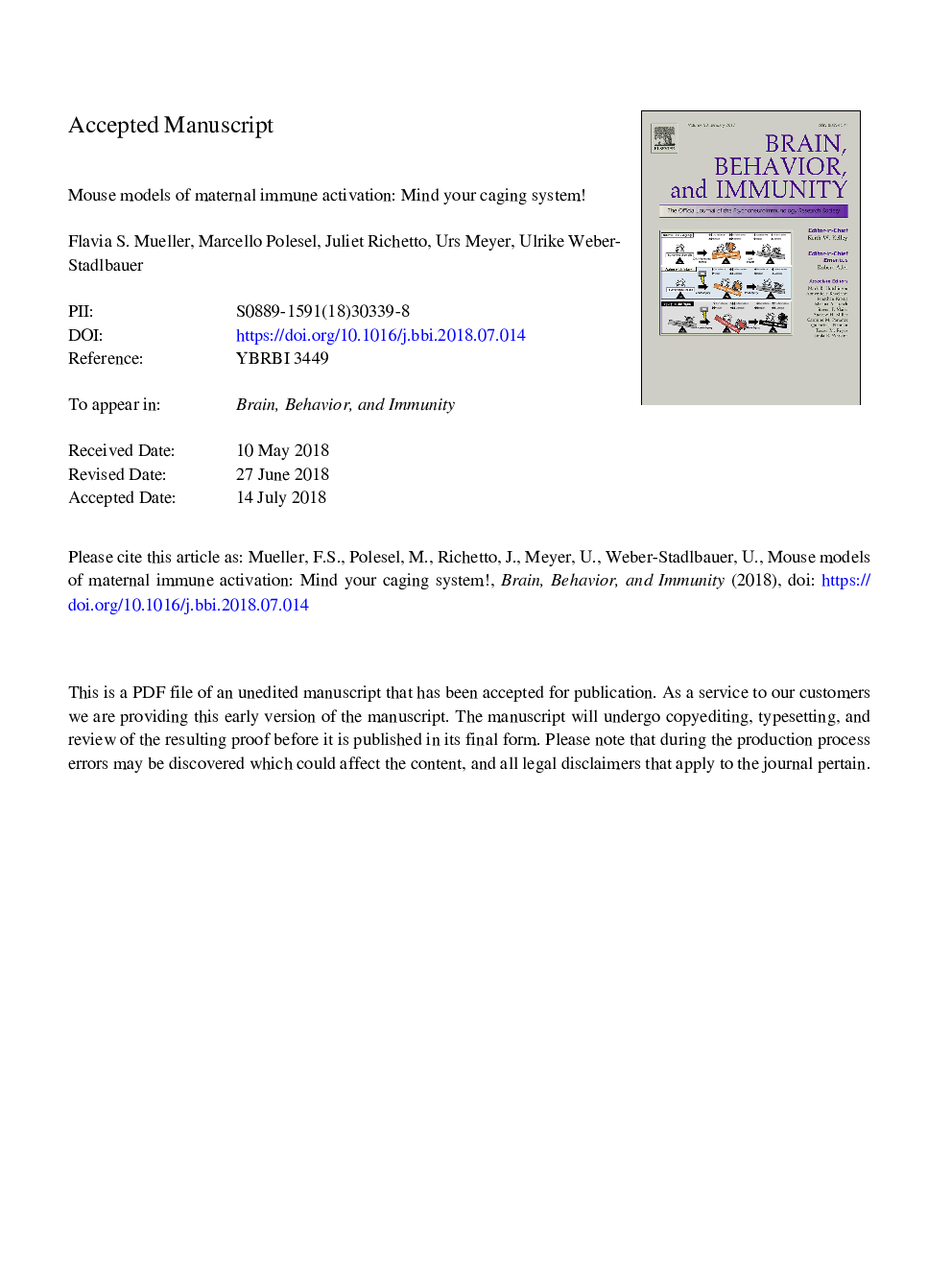| کد مقاله | کد نشریه | سال انتشار | مقاله انگلیسی | نسخه تمام متن |
|---|---|---|---|---|
| 8960772 | 1646430 | 2018 | 45 صفحه PDF | دانلود رایگان |
عنوان انگلیسی مقاله ISI
Mouse models of maternal immune activation: Mind your caging system!
ترجمه فارسی عنوان
مدل های ماوس فعال سازی ایمنی مادر: ذهن سیستم قفل شما!
دانلود مقاله + سفارش ترجمه
دانلود مقاله ISI انگلیسی
رایگان برای ایرانیان
کلمات کلیدی
موضوعات مرتبط
علوم زیستی و بیوفناوری
ایمنی شناسی و میکروب شناسی
ایمونولوژی
چکیده انگلیسی
Rodent models of maternal immune activation (MIA) are increasingly used as experimental tools to study neuronal and behavioral dysfunctions in relation to infection-mediated neurodevelopmental disorders. One of the most widely used MIA models is based on gestational administration of poly(I:C) (= polyriboinosinic-polyribocytdilic acid), a synthetic analog of double-stranded RNA that induces a cytokine-associated viral-like acute phase response. The effects of poly(I:C)-induced MIA on phenotypic changes in the offspring are known to be influenced by various factors, including the precise prenatal timing, genetic background, and immune stimulus intensity. Thus far, however, it has been largely ignored whether differences in the basic type of laboratory housing can similarly affect the outcomes of MIA models. Here, we examined this possibility by comparing the poly(I:C)-based MIA model in two housing systems that are commonly used in preclinical mouse research, namely the open cage (OC) and individually ventilated cage (IVC) systems. Pregnant C57BL6/N mice were kept in OCs or IVCs and treated with a low (1â¯mg/kg, i.v.) or high (5â¯mg/kg, i.v.) dose of poly(I:C), or with control vehicle solution. MIA or control treatment was induced on gestation day (GD) 9 or 12, and the resulting offspring were raised and maintained in OCs or IVCs until adulthood for behavioral testing. An additional cohort of dams was used to assess the influence of the different caging systems on poly(I:C)-induced cytokine and stress responses in the maternal plasma. Maternal poly(I:C) administration on GD9 caused a dose-dependent increase in spontaneous abortion in IVCs but not in OCs, whereas MIA in IVC systems during a later gestational time-point (GD12) did not affect pregnancy outcomes. Moreover, the precise type of caging system markedly affected maternal cytokines and chemokines at basal states and in response to poly(I:C) and further influenced the maternal levels of the stress hormone, corticosterone. The efficacy of MIA to induce deficits in working memory, social interaction, and sensorimotor gating in the adult offspring was influenced by the different housing conditions, the dosing of poly(I:C), and the precise prenatal timing. Taken together, the present study identifies the basic type of caging system as a novel factor that can confound the outcomes of MIA in mice. Our findings thus urge the need to consider and report the kind of laboratory housing systems used to implement MIA models. Providing this information seems pivotal to yield reproducible results in these models.
ناشر
Database: Elsevier - ScienceDirect (ساینس دایرکت)
Journal: Brain, Behavior, and Immunity - Volume 73, October 2018, Pages 643-660
Journal: Brain, Behavior, and Immunity - Volume 73, October 2018, Pages 643-660
نویسندگان
Flavia S. Mueller, Marcello Polesel, Juliet Richetto, Urs Meyer, Ulrike Weber-Stadlbauer,
